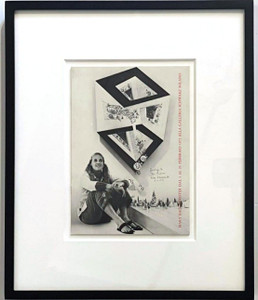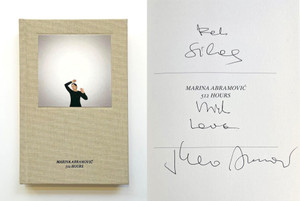
Mary Heilmann, To Be Someone (hand signed and inscribed "Love from Mary Heilmann"), 2007
Mary HeilmannCONTACT GALLERY FOR PRICE
Mary Heilmann
To Be Someone (hand signed and inscribed "Love from Mary Heilmann"), 2007
Hardback monograph with dust jacket (hand signed and inscribed by Mary Heilmann)
Warmly signed with love by Mary Heilmann on the half title page
10 3/4 × 8 × 1 inches
Unframed
This gorgeously illustrated hardback monograph with dust jacket was warmly signed "Love from Mary Heilmann" with black felt tip pen/marker on the half title page.
Makes a fantastic gift!
Book information:
Publisher: Prestel (May 1, 2007)
English; Hardcover; 192 pages with color and black and white illustrations
Publisher's blurb:
A pioneer of infusing abstract painting with elements from popular culture and craft traditions, Mary Heilmann (b.1940) is one of the preeminent abstract painters of her generation. Her deceptively simple, even offhand approach to painting--at once asserting ease, complexity, and boundless potentiality--now permeates contemporary abstraction, testifying to her broad influence. A San Francisco native who was part of the early development of conceptual and minimal art in New York, Heilmann committed herself to painting in the early 1970s.
This volume presents the first comprehensive overview of Heilmann's career. Essays by curator Elizabeth Armstrong, art historian Johanna Burton, and critic Dave Hickey explore her painting since 1972 as well as key earlier works and their relationship to her interests in ceramics, decorative arts, film, and music. Accompanying the first traveling retrospective exhibition of Heilmann's work, this timely and essential volume also details her impact on successive generations of artists and her substantial role in the revitalization of abstraction by a new generation of painters.
More about Mary Heilmann:
Influenced by 1960s counterculture, the free speech movement, and the surf ethos of her native California, Mary Heilmann ranks amongst the most influential abstract painters of her generation. Considered one of the preeminent contemporary Abstract painters, Heilmann’s practice overlays the analytical geometries of Minimalism with the spontaneous ethos of the Beat Generation, and are always distinguishable by their often unorthodox—always joyful—approach to color and form.
Raised in San Francisco and Los Angeles, Heilmann completed a degree in literature, before she studied ceramics at Berkeley. Only after moving to New York in 1968 did she begin to paint. While most artists at that time were experimenting with the concept of dematerialization and demanding that painting should avoid any references to experience outside the material presence of the work itself, Heilmann opted for painting, rebelling against the accepted rules. ‘Rather than following the decrees of modern, non-representational formalism, I started to understand that the essential decisions taken during the creative process were more and more related to content. The Modern movement was over…’
Since then, Heilmann has created compositions that evoke a variety of associations. Her work may be non-representational and based on an elementary, geometrical vocabulary—circles, squares, grids and stripes—but there is always something slightly eccentric, casual about them. The simplicity of the forms is played down by a deceptive form of nonchalance: the contours are not clearly defined. In some paintings, amorphous forms appear to melt into each other like liquid wax. Splashes of color can be discerned, sharp edges bleed for no apparent reason, and the ductus of the brushstrokes is always perceptible. Heilmann’s casual painting technique conceals a frequently complex structure that only gradually reveals itself to the viewer.
Courtesy of Hauser & Wirth






















